
- License:
- Short Description:
- This guideline is intended to provide information on electrochemical techniques used to mitigate the corrosion of steel in atmospherically exposed concrete structures. The information presented is based on testing and the experience of owners, engineers, contractors, and suppliers. This guideline includes information on impressed current and galvanic cathodic protection, electrochemical chloride extraction, and realkalization.
- Price:
- $0.00 - $62.00
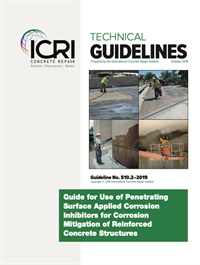
- Publication Date:
- Oct 01, 2019
- License:
- Short Description:
- Provides information and guidance for the selection, evaluation, and use of surface applied corrosion inhibitors (SACI) for corrosion mitigation and supplement sound judgement by engineers, consultants, or others specializing in the repair of reinforced concrete structures experiencing corrosion induced damage. Understanding the existing concrete conditions and corrosion levels in the structure, the function and limitations of SACI materials, requirements for proper application and quality assurance/control during application, and evaluation and monitoring the performance are addressed.
- Price:
- $31.00 - $62.00
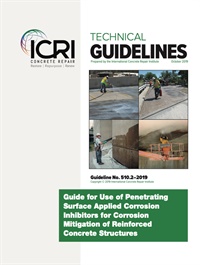
- License:
- Short Description:
- Provides information and guidance for the selection, evaluation, and use of surface applied corrosion inhibitors (SACI) for corrosion mitigation and supplement sound judgement by engineers, consultants, or others specializing in the repair of reinforced concrete structures experiencing corrosion induced damage. Understanding the existing concrete conditions and corrosion levels in the structure, the function and limitations of SACI materials, requirements for proper application and quality assurance/control during application, and evaluation and monitoring the performance are addressed.
- Price:
- $0.00 - $62.00
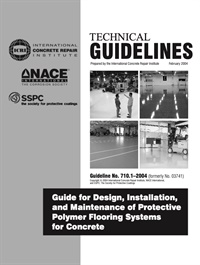
- License:
- Short Description:
- The information in this technical committee report deals with the design, installation, and maintenance of protective polymer flooring systems that are applied and directly bonded to concrete. Contains detailed information on the aspects of flooring technology, performance properties, surface preparation requirements, installation procedures, and testing to attain long-term service from a variety of polymer flooring systems. (Joint SSPC/NACE/ICRI document).
- Price:
- $31.00 - $62.00

- Publication Date:
- Jan 01, 2018
- License:
- Short Description:
- This is a reference specification that the architect/engineer can apply to any construction repair and rehabilitation project involving structural concrete by citing it in the project specifications. Mandatory requirements and optional requirements checklists are provided to assist the architect/engineer in supplementing the provisions of this specification, as required or needed, by designating or specifying individual project requirements. The first section covers general construction requirements for all repair work. The second section covers shoring and bracing of the structure or member to be repaired, and addresses sequencing of repair work as the structure is unloaded and reloaded. The third section covers concrete removal and preparation of the concrete substrate for repair, and defines common equipment and methods. The next five sections cover materials and proportioning of concrete; proprietary cementitious and polymer repair materials; reinforcement; production, placing...
- Price:
- $54.00 - $84.00
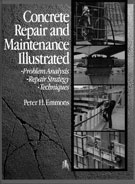
- Publication Date:
- Jan 01, 1994
- License:
- Short Description:
- This comprehensive book describes the causes, effects, and remedies for concrete wear and failure. It is a practical guide to evaluation of deterioration and its causes, selection of repair methods and materials, surface preparation, and quality assurance of the finished product. Hundreds of illustrations show users how to analyze, maintain, and repair concrete structures for optimal performance and cost-effectiveness.
- Price:
- $79.00 - $105.00
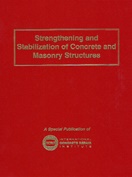
- Publication Date:
- Jan 01, 2003
- License:
- Short Description:
- This special publication is a compilation of existing articles on various structural strengthening, stiffening, and stabilization topics, including external bonded reinforcement, external post-tensioning, internal post-tensioning, section enlargement and overlays, supplemental framing and span shortening, and strengthening and stabilization of masonry structures. The purpose is to provide engineers and contractors with a single-source overview of the various materials and techniques available to solve strengthening, stiffening, and stabilization problems. The wealth of information provided should provide invaluable “food for thought” to facilitate the strengthening, stiffening, and stabilization design process.
- Price:
- $30.00 - $60.00
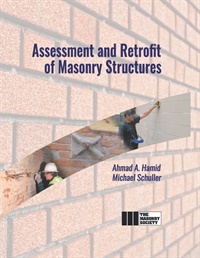
- Publication Date:
- Jul 24, 2020
- License:
- Short Description:
- This exciting new publication has been sought for years, and it fills a need for a practical and current guide on evaluating, testing, and, where needed, repairing existing masonry. The book provided background, reference material, and guidance to design professionals, building owners, and contractors on existing masonry. Construction characteristics of masonry structures, typical material properties, and analytical approaches are included for historic, transitional, and modern masonry construction typologies. The main focus of the book is structural stabilization, strengthening, and retrofit with maintenance and serviceability items (such as water penetration and cleaning) addressed as subtopics.
- Price:
- $180.00 - $225.00

- Publication Date:
- Jan 01, 2021
- License:
- Short Description:
- ACI and ICRI have published an updated “Guide to the Code for Assessment, Repair, and Rehabilitation of Existing Concrete Structures, A Companion to ACI 562-19.” This guide provides the licensed design professional with the knowledge, skill, and judgment to interpret and properly use ACI 562-19, and provides insight into the use and benefits of the code for contractors, material manufacturers, building owners, and building officials.
- Price:
- $79.00 - $129.00
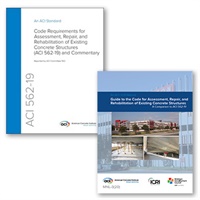
- License:
- Short Description:
- Purchase publication Code Requirements for Assessment, Repair, and Rehabilitation of Existing Concrete Structures and Commentary (ACI 562-19) and publication Guide to the Code for Evaluation, Repair, and Rehabilitation of Concrete Buildings (562MAN-20) together. Hard copies only.
- Price:
- $131.00 - $214.00
Please wait ...